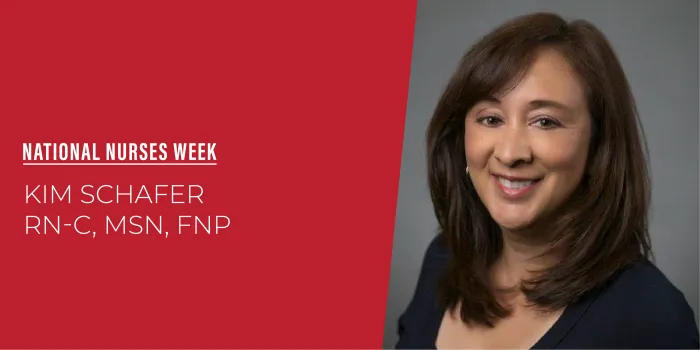In 1991, a fresh-out-of-nursing-school Kim Schafer, of Sacramento, California, wanted to work in pediatrics. “At the time, everybody was told, ‘You have to put in your two years of ‘med-surg’ first,’” she says. “But I lucked out.” Schafer landed her first-choice job in the pediatric intensive/special care unit at University of California Davis Medical Center. She loved it, spending nine years there. Eventually, though, she was ready for a change. When an opening arose for a pediatric nurse at the UC Davis Hemostasis and Thrombosis Center in 2000, she jumped at the opportunity. “And that’s how I got into hemophilia,” she says.
Over the next 19 years, Schafer not only witnessed significant changes in bleeding disorders treatments, but her career evolved as well. While working at the HTC, she went back to school and obtained her Masters in Nursing and post masters certificate as a family nurse practitioner, officially taking on that role at the HTC in 2017. As a nurse practitioner, Schafer’s responsibilities are “more in line with what the doctor does,” she says. She sees patients individually and directs their care plans. “It’s in collaboration with the physician, but I’m able to use the knowledge that I’ve gained over the last 20 years and apply it towards advanced practice,” she says.
Here, Schafer reflects on her time as an HTC nurse and on the critical role nurses play in the care and treatment of people with bleeding disorders and their families.
GOING FROM PEDIATRIC INTENSIVE CARE TO THE HTC
I took care of a lot of patients who were very sick in the ICU. You’d get trauma patients, you’d get cancer patients, you’d get patients with rare diseases. But when they would leave, I never knew what happened to them. After nine years, I was ready for a change.
EARLY DAYS AT THE HTC
I missed the generation of AIDS and hepatitis C, and I slid into the time in the early 2000s where prophylaxis was becoming the standard of care. I spent a lot of time educating families about prophylaxis and its benefits and the long-term risks of no prophylaxis. It was a change from on-demand treatment, where they would come into the clinic to take their acute bleeding treatments. Now there was more of an emphasis on home treatment and self infusion. I spent a lot of time on telephone triage, helping mothers, fathers and caregivers identify bleeding correctly, learn home infusion and successfully treat at home.
THE ROLE OF THE HTC NURSE
I view nurses as the "glue" that keeps the treatment center running smoothly. They’re in the clinic seeing the patients. They’re in their office answering the telephone triages. They’re following up on factor orders. They’re following up on insurance issues. Anything that comes up with the patient or the family, nurses are really the first people that address it, and then they collaborate with the rest of the team.
PERSONAL EVOLUTION
About 10 years ago, our adult nurse left her position. Though I only had pediatric experience, I stepped in to learn adult care because we were lacking a nurse. So now I am able to see both pediatric and adult patients. In many ways adults’ medical needs are a lot different than the pediatric side of things. Understanding the challenges that adults face is helpful when teaching the younger generation to understand what could happen if they don’t adhere to their treatments.
THE BIGGEST CHANGES IN BLEEDING DISORDERS TREATMENT
I think it’s been the advance in the factor products. There’s a lot of choices for families. And that means the physicians and the treatment center team also have to be knowledgeable about these different treatments so they can explain it to the families and patients. There’s a lot of misinformation out there. There’s social media, where they can get some wrong information. So our team has to be on top of making sure that we understand the clinical side of things.
THE BEST PARTS OF THE JOB
Everything! You have new parents who are devastated and scared when they hear they have a son with hemophilia and they’ve never even heard of it. Nurses help families become educated about bleeding disorders. We hold their hands, give them hugs, sometimes cry with them and walk them through one of the most challenging times of their lives. And then you turn around and see them come to clinic every six months, and they’re just flourishing. To know that you somehow made a difference in that family to help them overcome that, that’s a very fulfilling feeling.
And for me, because I’ve been doing it for a long time, babies that were born when I first started are now graduating from high school, and kids who were little are graduating from college and handling all the demands of life in addition to living with a chronic illness.
I set out every day to make a difference in someone’s life and knowing that I do makes me feel very fulfilled. I work at a great treatment center where everybody is considered a valuable team member. It’s very rewarding to work in an HTC.

